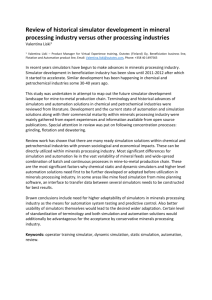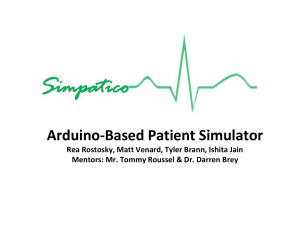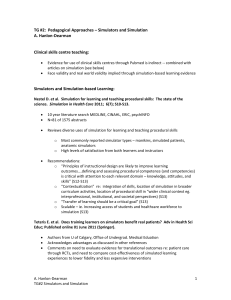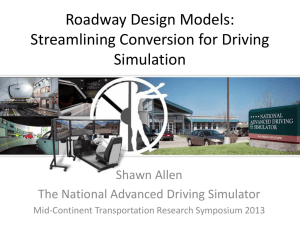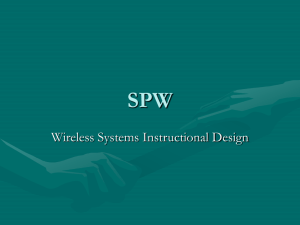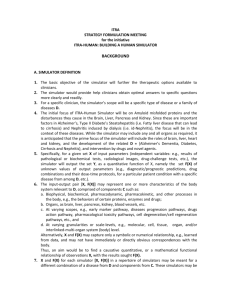- (EPD) Evidence-Based Healthcare Professional
advertisement
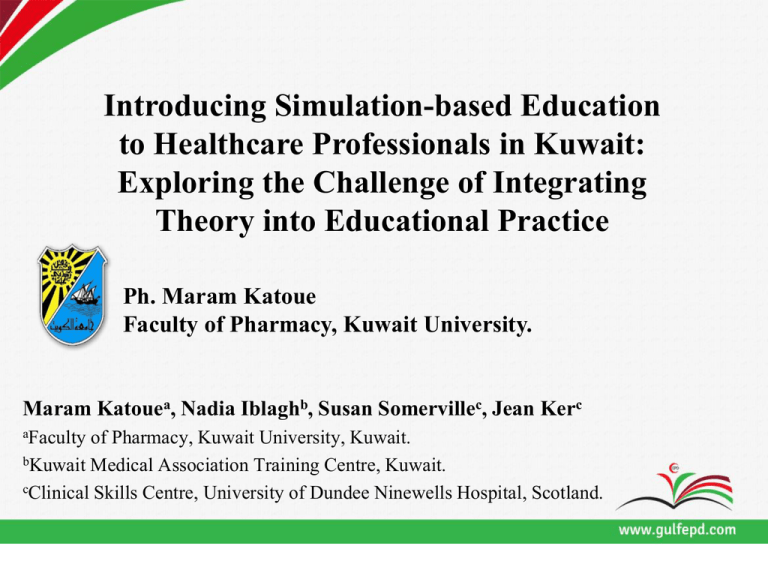
Introducing Simulation-based Education to Healthcare Professionals in Kuwait: Exploring the Challenge of Integrating Theory into Educational Practice Ph. Maram Katoue Faculty of Pharmacy, Kuwait University. Maram Katouea, Nadia Iblaghb, Susan Somervillec, Jean Kerc aFaculty of Pharmacy, Kuwait University, Kuwait. bKuwait Medical Association Training Centre, Kuwait. cClinical Skills Centre, University of Dundee Ninewells Hospital, Scotland. Simulation-based Education Simulation is an instructional technique that substitutes or amplifies real clinical experiences with guided educational experiences which evoke or replicate essential elements of the real world in an interactive way. (Quality & safety in health care 2004; 13 Suppl 1:2-10) Simulators and Simulated Patients Introduction Using simulators for learning standards of safe clinical practice requires faculty development. The National Clinical Skills Centre in Kuwait was established in 2011 at the Dasman Diabetes Institute. Introduction The MSc. Programme in Diabetes Care and Education: • Clinical • Management • Research • Education • Simulation-based educator Aim of the Study To investigate the initial perceptions of the use of simulators by healthcare professionals who undertook a module on simulation for clinical skills education. To explore their subsequent ability to transform the theoretical knowledge gained from the module into their educational practice. Methods Participants recruitment: • • Convenience sample Multidisciplinary health care professionals Methods 1) Exploration of theoretical understanding: Series of five clinical skills stations: • Station 1 SimMan/Simbaby • Station 2 Resusi Anne with resuscitation kit/AED • Station 3 Part task trainers (e.g. venepuncture arm, ophthalmoscopes and heads, catheterisation models) • Station 4 Harvey • Station 5 Simulated Patient with script Methods Structured questionnaire: • • • • How would you classify this simulator? How would you describe the fidelity of the simulator? When would you use it in your teaching? What would be the challenges of using this simulator in your practice? Methods 2) Exploration of educator practice: Tutor analysis of video record of teaching: • Identify what simulator was used in the educational practice of the novice educators • Determine the appropriateness of the choice of the simulator for the clinical skill being taught Self-reported analysis of use of simulators Results Study participants included those who undertook the clinical skills and simulation module in 2012, 2013. The two cohorts included 23 physicians, 6 pharmacists and 8 other healthcare professionals. Results Exploration of theoretical understanding: • Participants were able to determine the classification of the simulator, its fidelity and possible applications. • Challenges identified: • Limited availability • Lack of realism • Requirement for technical support for the highfidelity simulators • Need for special training for the simulated patients Results Exploration of Educator Practice: • Tutor analysis of video record of teaching: • Use of part task trainers to teach procedural skills. • Self reported analysis of use of simulators: • Limited justification of choice. • Little reference to the simulator’s classification, fidelity, or the challenges in its use. Conclusion There is a theory-practice gap in the use of simulation by novice educators. Further study: • Need to explore underlying reasoning/influences in the choices of simulators made by novice educators. A potential Community of Practice Simulation Use in my Educational Practice Acknowledgements Dasman Diabetes Institute Module leads from Dundee University: • Prof. Jean Ker • Dr. Mairi Scott • Susan Somerville Study participants Thank You



